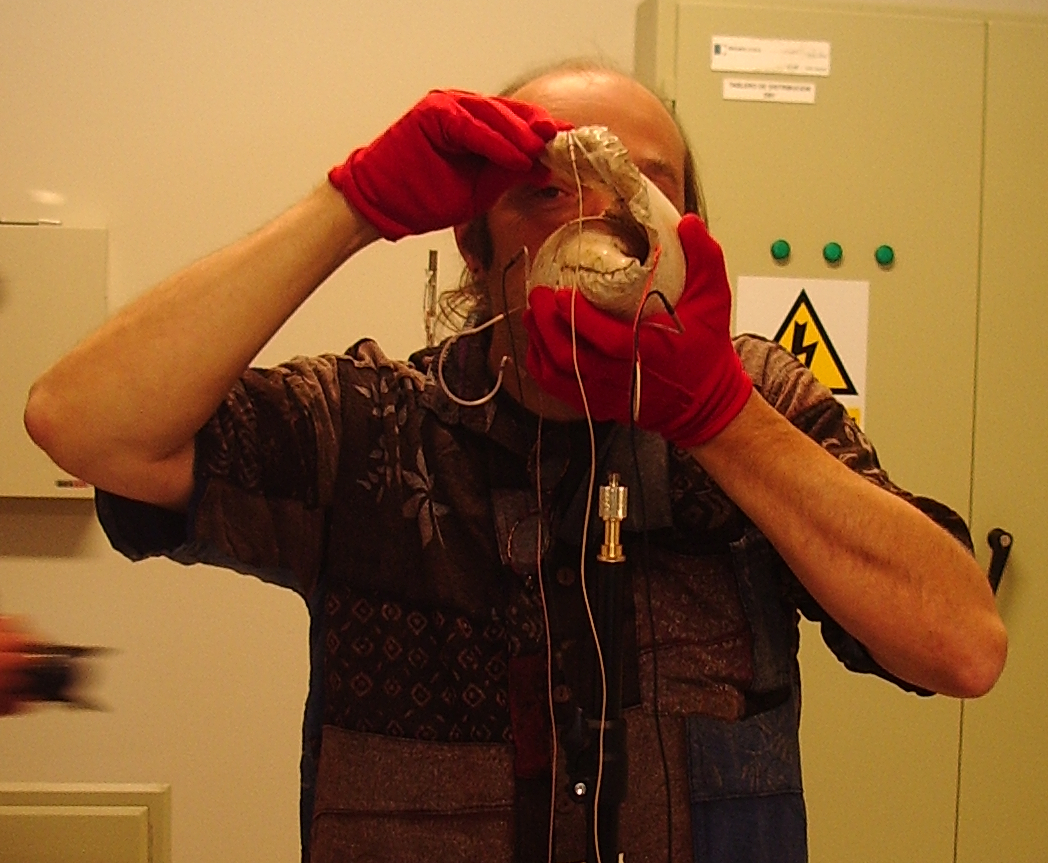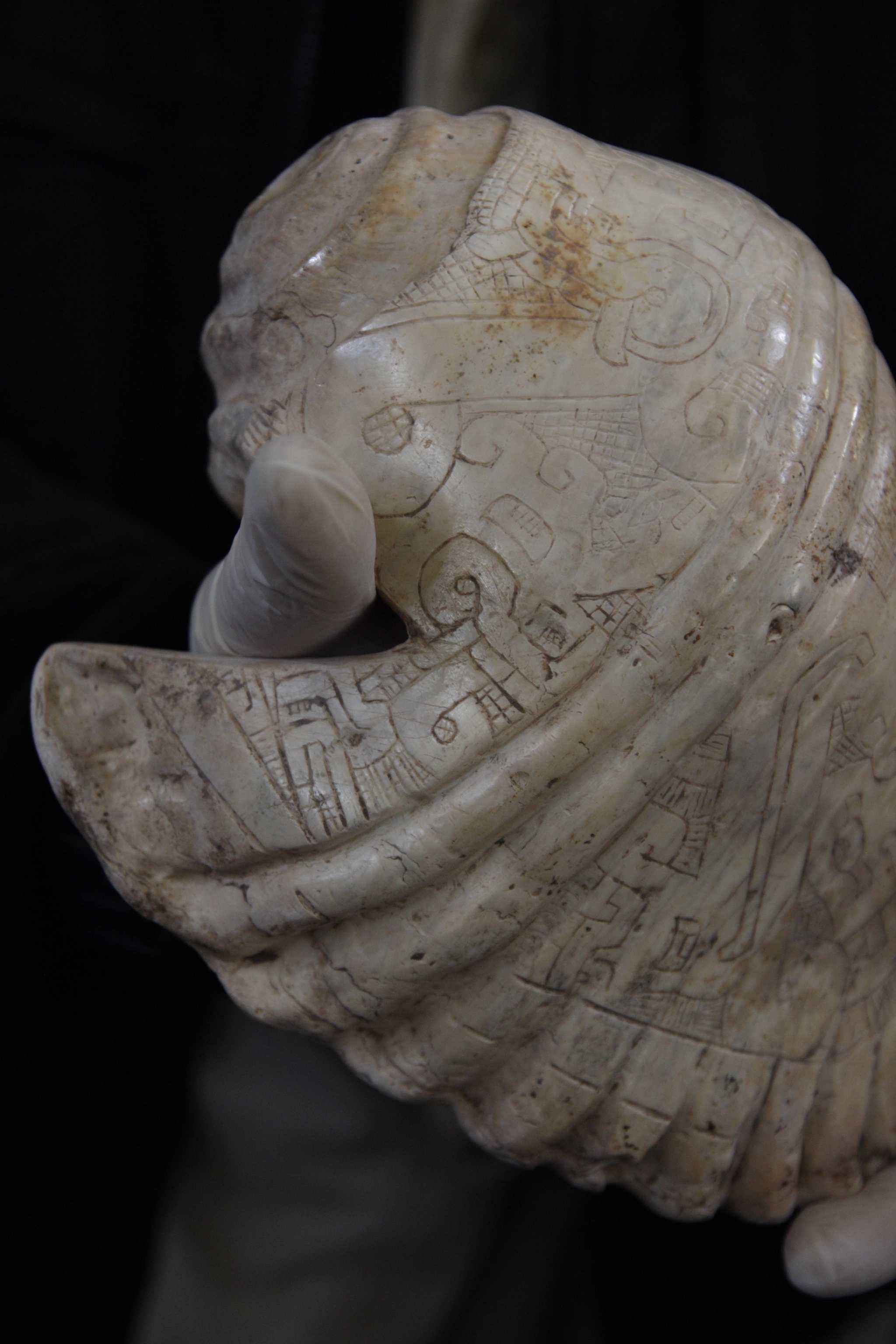In October 2011, Dr. Perry R. Cook gave fellow Chavín archaeoacoustics researcher Miriam Kolar an interview about his experience making acoustic measurements of the Chavín Strombus galeatus pututus in 2008.
MAK: We've been studying the Chavín pututus now since 2008, and you are the archaeoacoustics team member who has examined and played them all from the perspective of an experienced aerophones player. Do you have any general impressions about them as a group, in comparison or contrast with other marine shell instruments you've played?
PRC: Except for the ones that are blocked or distressed by holes etc., they play pretty much like many modern shells I have. The important things acoustically about shells in general is that that they flare exponentially and are smooth on the inside. For the Chavín shells that are in good shape, they play very well and afford stable tones and one or two (or even three) good overblown harmonics (overtones, bugle tones).
One might think from the outer appearance that different species play radically differently, since they look so dissimilar, but generally they have to be smooth on the inside or the snail wouldn't want to live in there :-). I found a paper somewhere that said that the Strombus had changed in size over the last few thousand years, but their theory that it was a side effect of excessive fishing of that species. Generally, a couple thousand years isn't that long for pretty ancient creatures like snails.
They are very dense, and pretty large (tho I have larger modern shells) and thus heavy. [MAK: The instruments range from approximately 1.5 to 2 kg]. Also, the aperture at the open end is sort of narrow, and doesn't afford putting the hand in the shell as far as some species allow for (tritons, whelks, and some others).

MAK: You spent a lot of time last year working through the acoustic data analysis of the measurements from the sessions you played. How has your understanding of the pututus changed (through studying them from a more objective/data-driven perspective) since those first two days of measurements?
PRC: Yea a little. Some of the things we found about the particular "pathological" shells in our data. And, certainly living with the sound files, editing, and listening closely in a studio at roughly sea level is very different from playing them at 2 Miles altitude in the cold! Many things I wish we had had time to do; look at various hand positions within the bell, play some more musical passages, etc. I still need to look for the overtone data. I hope to take out a day or two and pour through for that. We also still should look at the area functions/mouthpiece area estimates of some of the other pathological shells to see if we can see blockages or anomalies inside indicated.
MAK: The "Chavín cut" (that now-famous v-shaped notch to the shell's upper apical lip) has brought a lot of speculation as to its purpose, and you hypothesized that it could stem from an essential underlying need to remove at least part of the shell's upper lip in forming the instrument mouthpiece. This shaping is necessary in order to flatten the mouthpiece area enough to be able to get the shell close to the face (and the larger the player's nose, the more necessary it is!). Other researchers have called the cut a "hand-grip" [Dr. John W. Rick, Parker Van Valkenburgh] and further suggested that the notch facilitates tonal shaping using hand insertion, which it does permit, but I would like your feedback on my alternate interpretation. While the cut allows the instrument to rest securely between the thumb and index finger of a person holding it (and this is not comfortable/possible without the notch), for functional dynamic reasons, I question that the notch location is correct to facilitate tonal shaping as speculated. In watching various Andean pututu players, and in doing my own experimentation with a variety of modern Strombus galeatus pututus, it seems that the cleanest (and sometimes only) position for changing pitch with the hand is to insert it nearer to the opposite (smaller) end of the shell. During our time-constrained measurement sessions, we were focused on recording the sounding tones of the pututus, and did not measure pitch bends using this technique. In your practice time with the instruments, did you experiment with this? What do you think about my hypothesis?

PRC: I think many of these are plausible, but none seem to explain the large size of some of the cutouts. I do know that for the one shell I worked, it was necessary to make some sort of cut to get a playable mouthpiece. I also noted that depending on the rotational orientation of the shell, parts of it banged into my nose, which would be taken care of by a cut away of part of the shell. I do not think that tonal quality would be affected much, and in fact we could easily check this by taking a few modern Strombus shells, working them to form the mouthpiece (observing if any and how many require some cut to form the mouthpiece), play and measure them, then do a deep(er) Chavín-style Cut, and play/ measure them again. We might wanna put this on our list for our Pututu-Jam at CCRMA whenever we get to do that. I think your early theory about visibility might be a good one as well, again depending on rotational orientation they used in actual practice. If it were for vision and/or nose clearance, that would set the orientation, unless they had their heads tilted at some odd angle.

MAK: During your career in computer music and acoustics (please correct me if you prefer another characterization!) you have done some psychoacoustic research, and seem to always connect your other work back to human auditory perception. In what ways might we explore this dimension in regard to the Chavín pututus?
PRC: Clearly the most important is how these shells interact with the galleries, and perhaps the entire valley where Chavin is located. We don't know if the shells were played individually, in pairs, trios, or the whole group at once. It's pretty clear (to me) that they were not selected to form or fill a traditional scale as such, but perhaps they were selected to be near a particular pitch or range of pitches. I think you're finding things in the galleries about some special pitches, yes?
MAK: That's for sure, and more to come on that topic, soon! Related to that, my next question: Even in professional acoustics forums, discussions that introduce the concept of beats and amplitude modulation ("a form of wave interference", and "a phenomenon present in the linear response of the system", to quote Bill Hartmann) frequently run amuck in confusion, misinterpretation of explanations, and lack of common terminology between acousticians and musicians. In Chavín, we noted that while performing together multiple pututus, a strong beating effect occurs, that can be heard and often physically sensed by listeners. How does this sensation differ (or not) for the players? Does the instrument/player coupling alter the effect perceived by listeners? Is there an attentional difference for the player that diminishes or negates the effect? Do you have anything else to say about the killer-combo of pututus, beats, and human auditory perception?
PRC: For brass players, the stapes muscles tighten (this is the middle ear's automatic gain circuit), even prior to playing a note. So it's not as loud at the player's ear drums as for the "audience," also because the shell is not pointed at the player's ear. But the player is the closest to the shell, and the player has lots of internal bone-conducted sound through their teeth, jawbones, skull, into the middle/inner ear. So the low frequency components are accentuated for the player's tone, but not for other tones. So the beats likely aren't as pronounced for each of two players as for the non-player observer. They'd be there but not as strong.
However, if players are really close together, the wavefronts can actually get into the shells, and the lips of the players can phase lock. Players can also bend the pitch using their lips (this is called "lipping" in brass circles) so beats could be made more or less severe. Lots of players together, however, especially at the pitch spread we observed in the Chavín collection, wouldn't lock but just sound like a tone cluster (another important musical compositional technique, which by the way you might consider looking into the literature on composers and compositions that used lots of tone clusters, especially brass).
MAK: To conclude, I want to ask you about the future! From your perspective, what are the most important next research steps to gain a better understanding of these instruments and their place in the Chavín archaeological context?
PRC:
a) Pitch bending with the hand, various positions from full open to highly closed.
b) More data on radiation, especially in the presence of a).
c) Psychoacoustics of clusters, beats, and subharmonics. Theories could possibly be checked with human subjects using the sound files we collected already.
d) Research c) especially in the simulated (or real ???) galleries.
e) The "Cut" experiments as described above.
f) Do high-res 3D MRI scans of a couple of modern shells to get pictures of the exact inner shapes. Ideally it would be nice to get all of the actual Chavín pututus to a hospital in Peru and get them scanned in this way.
g) Feels like I'm leaving something out, you remember anything else?
MAK: That's a great list, covers the topics we've discussed and cross-checks with my own!
To Be Continued . . .
For more information, see:
"Acoustic Analysis of the Chavín Pututus (Strombus galeatus marine shell trumpets)"
Perry R. Cook, Jonathan S. Abel, Miriam A. Kolar, Patty Huang, Jyri Huopaniemi, John W. Rick, Chris Chafe, John M. Chowning
Invited paper presented at 2nd Pan American/Iberian Meeting on Acoustics, Cancún, Mexico, November 2010.